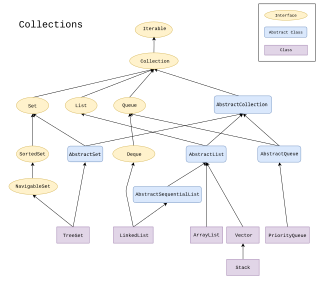Related Research Articles

Java is a class-based, object-oriented programming language that is designed to have as few implementation dependencies as possible. It is a general-purpose programming language intended to let application developers write once, run anywhere (WORA), meaning that compiled Java code can run on all platforms that support Java without the need for recompilation. Java applications are typically compiled to bytecode that can run on any Java virtual machine (JVM) regardless of the underlying computer architecture. The syntax of Java is similar to C and C++, but has fewer low-level facilities than either of them. The Java runtime provides dynamic capabilities that are typically not available in traditional compiled languages. As of 2019, Java was one of the most popular programming languages in use according to GitHub, particularly for client-server web applications, with a reported 9 million developers.
Jakarta Enterprise Beans is one of several Java APIs for modular construction of enterprise software. EJB is a server-side software component that encapsulates business logic of an application. An EJB web container provides a runtime environment for web related software components, including computer security, Java servlet lifecycle management, transaction processing, and other web services. The EJB specification is a subset of the Java EE specification.
The Java Naming and Directory Interface (JNDI) is a Java API for a directory service that allows Java software clients to discover and look up data and resources via a name. Like all Java APIs that interface with host systems, JNDI is independent of the underlying implementation. Additionally, it specifies a service provider interface (SPI) that allows directory service implementations to be plugged into the framework. The information looked up via JNDI may be supplied by a server, a flat file, or a database; the choice is up to the implementation used.
The Jakarta Messaging API is a Java application programming interface (API) for message-oriented middleware. It provides generic messaging models, able to handle the producer–consumer problem, that can be used to facilitate the sending and receiving of messages between software systems. Jakarta Messaging is a part of Jakarta EE and was originally defined by a specification developed at Sun Microsystems before being guided by the Java Community Process.
Java Platform, Standard Edition is a computing platform for development and deployment of portable code for desktop and server environments. Java SE was formerly known as Java 2 Platform, Standard Edition (J2SE).
The Common Object Request Broker Architecture (CORBA) is a standard defined by the Object Management Group (OMG) designed to facilitate the communication of systems that are deployed on diverse platforms. CORBA enables collaboration between systems on different operating systems, programming languages, and computing hardware. CORBA uses an object-oriented model although the systems that use the CORBA do not have to be object-oriented. CORBA is an example of the distributed object paradigm.

A JAR is a package file format typically used to aggregate many Java class files and associated metadata and resources into one file for distribution.

Swing is a GUI widget toolkit for Java. It is part of Oracle's Java Foundation Classes (JFC) – an API for providing a graphical user interface (GUI) for Java programs.
Message-oriented middleware (MOM) is software or hardware infrastructure supporting sending and receiving messages between distributed systems. MOM allows application modules to be distributed over heterogeneous platforms and reduces the complexity of developing applications that span multiple operating systems and network protocols. The middleware creates a distributed communications layer that insulates the application developer from the details of the various operating systems and network interfaces. APIs that extend across diverse platforms and networks are typically provided by MOM.
Windows Management Instrumentation (WMI) consists of a set of extensions to the Windows Driver Model that provides an operating system interface through which instrumented components provide information and notification. WMI is Microsoft's implementation of the Web-Based Enterprise Management (WBEM) and Common Information Model (CIM) standards from the Distributed Management Task Force (DMTF).
Java Management Extensions (JMX) is a Java technology that supplies tools for managing and monitoring applications, system objects, devices and service-oriented networks. Those resources are represented by objects called MBeans. In the API, classes can be dynamically loaded and instantiated. Managing and monitoring applications can be designed and developed using the Java Dynamic Management Kit.
The Web Services Invocation Framework (WSIF) supports a simple and flexible Java API for invoking any Web Services Description Language (WSDL)-described service.

The Java collections framework is a set of classes and interfaces that implement commonly reusable collection data structures.
Interface-based programming, also known as interface-based architecture, is an architectural pattern for implementing modular programming at the component level in an object-oriented programming language which does not have a module system. An example of such a language is Java, which, does not have a module system at the level of components. Java has a package system, but Java software components typically consist of multiple Java packages – and in any case, interface programming can provide advantages over merely using Java packages, even if a component only consists of a single Java package.
The Simple API for Grid Applications (SAGA) is a family of related standards specified by the Open Grid Forum to define an application programming interface (API) for common distributed computing functionality.
The Java Class Library (JCL) is a set of dynamically loadable libraries that Java Virtual Machine (JVM) languages can call at run time. Because the Java Platform is not dependent on a specific operating system, applications cannot rely on any of the platform-native libraries. Instead, the Java Platform provides a comprehensive set of standard class libraries, containing the functions common to modern operating systems.
Component Object Model (COM) is a binary-interface standard for software components introduced by Microsoft in 1993. It is used to enable inter-process communication object creation in a large range of programming languages. COM is the basis for several other Microsoft technologies and frameworks, including OLE, OLE Automation, Browser Helper Object, ActiveX, COM+, DCOM, the Windows shell, DirectX, UMDF and Windows Runtime. The essence of COM is a language-neutral way of implementing objects that can be used in environments different from the one in which they were created, even across machine boundaries. For well-authored components, COM allows reuse of objects with no knowledge of their internal implementation, as it forces component implementers to provide well-defined interfaces that are separated from the implementation. The different allocation semantics of languages are accommodated by making objects responsible for their own creation and destruction through reference-counting. Type conversion casting between different interfaces of an object is achieved through the QueryInterface method. The preferred method of "inheritance" within COM is the creation of sub-objects to which method "calls" are delegated.
In computing, an application programming interface (API) is an interface that defines interactions between multiple software applications or mixed hardware-software intermediaries. It defines the kinds of calls or requests that can be made, how to make them, the data formats that should be used, the conventions to follow, etc. It can also provide extension mechanisms so that users can extend existing functionality in various ways and to varying degrees. An API can be entirely custom, specific to a component, or designed based on an industry-standard to ensure interoperability. Through information hiding, APIs enable modular programming, allowing users to use the interface independently of the implementation.

Apache Aries, a Blueprint Container implementations and extensions of application-focused specifications defined by OSGi Enterprise Expert Group. The project aims to deliver a set of pluggable Java components enabling an enterprise OSGi application programming model. The Aries project Content includes the following:
References
- 1 2 "Introduction to the Service Provider Interfaces". Oracle Java Documentation.
Services are units of sound-handling functionality that are automatically available when an application program makes use of an implementation of the Java Sound API
- 1 2 Thribhuvan Thakur (November 18, 2009). "Service Provider Interface: Creating Extensible Java Applications". Developer.com.
A service provider interface (SPI) is the set of public interfaces and abstract classes that a service defines. A SPI may be represented by a single interface (type) or abstract class or a set of interfaces or abstract classes that define the service contract.
- ↑ Seacord, C. Robert & Wrage, Lutz (July 2002). "Replaceable Components and the Service Provider Interface". Software Engineering Institute (CMU).
- ↑ "ServiceLoader".
